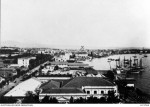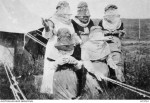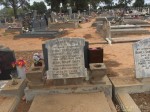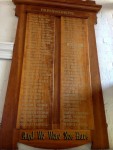GIDDINGS, Ethel May
Introduction
Ethel Giddings came from a large family in Maryborough, Victoria. After training at Clunes Hospital, she worked in various hospitals, large and small, city and country, in three states. Highly experienced, she enlisted in the Australian Army Nursing Service in 1916, and served first in India and then in Salonika (Greece). She held the rank of Head Sister (Temporary) from 1917 to 1919, and was decorated with the Royal Red Cross (2nd Class) for her work at Salonika.
After her return to Australia, she ran a private hospital in Mildura for many years until ill-health forced her retirement.
Giddings married late in life. She died in Mildura in July 1968.
Ethel Giddings is commemorated at St Peter’s Church, Eastern Hill, East Melbourne on the Honour Board of parishioners who served in the Great War.
Before the War
Ethel Giddings (1877–1968) was born in the town of Maryborough in central Victoria to James Giddings (1830–94), a Wiltshire-born bricklayer and his Cornish wife Susan (nee Millet/Mellet) (1836-96). The couple had married in 1855 in Victoria. Ethel was the eighth of possibly nine children born over a 23 year period from 1856 to 1879. Several died in infancy.
She was known variously as Mary Ann Ethel, Ethel Mary Ann and Ethel May.
Ethel Giddings trained at the hospital in Clunes, about 30 kms from her home town Maryborough, completing both the hospital certificate and the Royal Victorian Trained Nurses Association requirements in 1904.
In the ten years after her training, Giddings nursed in hospitals in three states: Wangaratta (1904-05) and Daylesford (1905) in country Victoria, Deniliquin in NSW (1906) and the ‘Austin Hospital for Incurables’ in Melbourne. She was appointed matron of the hospitals in two mining towns, Walhalla in Gippsland in 1910, then Beaconsfield in Tasmania in 1914. Both were tiny, with a handful of patients at any one time. She also did midwifery training at the Women’s Hospital in Carlton and nursed at Mena Hospital in East Melbourne, during which time she attended St Peter’s Church Eastern Hill (St Peter’s Eastern Hill, Address Book 1911-13). At the time of her enlistment, she was working for Dr Romeo in Brushgrove, near Grafton in northern NSW, for £80 per annum (Ethel Mary Ann Giddings, Service Record [NAA]).
Giddings had built up considerable experience by the time she enlisted: the accidents and emergencies of mining towns and farming area hospitals, nursing ‘incurable’ patients (in this context primarily TB), and the general and surgical work of a private hospital such as Mena House. Nothing however could have prepared Giddings or any other members of the Australian Army Nursing Service for their service abroad.
Ethel Giddings enlisted in August 1916. She was the only member of her immediate family to enlist. Her surviving brothers and sisters had married.
In accordance with policy introduced during the war that nurses work in base hospitals before overseas service, Giddings was sent to the Base Hospital in St Kilda Rd, Melbourne with the rank of Sister (Punch [Melbourne], 17.2.1916, p17). After some months there she formally enlisted in the Australian Army Nursing Service on 22 August 1916 and embarked the same day for India.
During the War
India was the destination of 20% of the AANS who served but it was not a declared a theatre of war, a source of frustration to many who longed to be closer to the action. (For the AANS in India, see Ruth Rae, Reading between unwritten lines: Australian Army Nurses in India, https://www.awm.gov.au/journal/j36/nurses/; M. Barker, Nightingales in the Mud: The Digger Sisters of the Great War (1989)). British hospitals in Bombay (Mumbai), Deolali and Poona with staffed by British medical officers; matrons and nurses were predominantly Australian.
Giddings was sent on her arrival to the Cumballa War Hospital in Bombay. Located on Malabar Hill above the harbor, Cumballa had 600 beds for British casualties from Mesopotamia (Iraq). Although Cumballa and the other hospitals in India were far from the fighting, the illness and injuries were severe and demanded heaving nursing. Emaciation from dysentery and malarial was common; some patients survived but others did not.
After three months at Cumballa, Giddings was transferred to the Deccan War Hospital in Poona, 150 kilometres from Bombay, in December 1916. She was there nearly eight months, during which time the hospital underwent a massive expansion to 1000 beds. The matron and 50 or so nurses were Australian, the doctors and orderlies were English. Like the Cumballa patients, those at Deccan were casualties from the fighting between the British and Turks in Mesopotamia (Iraq) brought by hospital ship to India. They were suffering from battle wounds and a range of illnesses including malaria, dysentery, cholera and the effects of severe heat stroke (Barker, Nightingales in the Mud, p76).
The climate (summer, monsoon and winter) was palatable rather than extreme, though some found it trying. Mosquitoes were rife, as was malaria. Giddings appears to have escaped malaria.
A year after she had left Australia, Giddings was transferred from India to Salonika in Greece. She arrived shortly after the contingent almost 300 nurses despatched from Australia under Matrons Jessie McHardie White and Ethelda Uren to Salonika to serve in British hospitals there. She remained there for the duration of the war.
The sea voyage from Bombay to Greece unnerved Giddings. She wrote home to the St Peter's parish, urging them to pray for those at sea and conveying the tension:
All the men passengers are taking their turn at watching on deck. They must feel that women are a terrible responsibility ... I have never realised until today how awful it must be for those at sea. No chance to run away from danger. If it comes, one must take it and trust in Providence. (Ecclesia, 1.1o.1917 [ancestry.com.au])
She may or may not have been aware that the ship Mooltan had been hit just days after McHardie White and her nurses had disembarked.
In 1917, the major conflicts in the area were between the British and the Bulgarians. There were several large British hospitals at Salonika which were staffed by British medical officers and Australian matrons and nurses: No 42, 60 and 66 General Hospitals. Nurses were rotated around these large hospitals.
While 100 kilometres from fighting, Salonika was a notoriously difficult posting. The patients, mainly British ‘tommies’, suffered from severe malaria and dysentery. Many wards were tented which made for very challenging nursing in the environment as described by Nurse Ruby Dickinson, a colleague of Giddings’ and fellow parishioner at St Peter’s Eastern Hill (Matron Kellett Interviews, AWM 41/1072, Australian War Memorial). Dickinson described the patients as ‘depressed [and] lethargic’. The climate consisted of extremes of heat and cold, with limited supplies of water in summer and fuel in winter. The ferocious ‘vardar’ winds made it a challenge to keep personnel, patients and tents upright, to the extent that 60 General Hospital was relocated from the hills to nearer the town during the winter months. The town of Salonika, severely damaged by fire shortly before the nurses arrived, was dirty, unappealing and largely out-of-bounds. Food, fresh food in particular, was in short supply due to the fire and the difficulties of getting supplies through dangerous waters.
Salonika did offer compensations. Spring was almost indescribably beautiful, with intoxicating fields of cornflowers and a climate ideal for sightseeing and picnics. Matron McHardie White and other nurses in their accounts describe a place which was almost Jekyll and Hyde like in its contrasts (Matron Kellett Interviews, AWM 41/1072, Australian War Memorial).
Like most nurses on Salonika, Giddings worked in various hospitals staffed by Australians matrons and nurses. She was initially attached to 66 General Hospital which was situated in the hills above the town although she later had a period at 60 General Hospital nearby. Her patients were mainly malaria victims, some with very severe forms of the disease. The nursing involved pioneering treatment methods which proved highly effective.
She also nursed at 42 General Hospital where dysentery patients were housed. Conditions were less than ideal and the hospital was relocated several times. Initially sited on a horse and mule dump on the edge of the town, 42GH was re-established further out, on the edge of a ravine which proved mosquito-infested. It returned to its original site.
Given the circumstances, it is scarcely surprising that many Australian nurses who served at Salonika became ill with malaria and/dysentery. Sixty at least were repatriated back to Australia via England because their health failed.
Giddings appears not to have contracted either disease but over the course of her 18 months at Salonika, she was sent on four separate occasions for periods of rest in the Red Cross Convalescent Home there.
Giddings was decorated with the Royal Red Cross (2nd Class) for her work at Salonika. She had been promoted to Head Sister (Temporary) shortly after her arrival and held that rank for the duration of her time there (Giddings, Service Record).
In February 1919, three months after the armistice was signed, Giddings left Salonika for England. She remained for some months, taking advantage of the provision for ‘non military employment’ (NME) with pay, living allowance and fees. She used it for a course at the well-known and influential National Training School of Cookery in London (Giddings, Service Record). While there she received her Royal Red Cross (2nd Class) from King George V at Buckingham Palace.
After the War
Sister Ethel Giddings RRC (2nd Class) left England for Australia with other repatriated nurses, officers and men in August 1919. She was discharged from the AANS on 24 January 1920, aged 43.
She returned anaemic, run-down and in ‘fair’ condition (Giddings, Service Record).
Two public receptions with dignitaries, speeches and bands were held in Giddings’ honour in Clunes where she had begun her nursing. One she shared with a local private; he responded for himself but Giddings’ brother responded on her behalf. The other she shared with another local returned nurse (Ballarat Star, 21.10.1919, p6; 31.10.1919, p6).
In mid 1920, Giddings and another nurse opened a private hospital in Mildura in north west Victoria, on the same street where her brother, a well-known shop proprietor and citizen in the town, lived. ‘Sister Giddings Private Hospital’ (later Kikee, named after an Indian town near Poona where she had worked) ran in competition to the Mildura public hospital, taking medical, surgical and gynaecological patients for £5/5/- a week.
Giddings operated the hospital with increasing difficulty as ill-health forced her to give up nursing for periods each year, then for several years at a time. Her wartime anaemia persisted and she suffered from various other ailments. In 1932 she took an extended break from the hospital (UNA, Vol. XXX (1), 1.1.1932, p14) and in 1935 travelled to England for a two month period, likely for her health and/or as a travelling nursing companion (UK Incoming Passenger Lists; UK, Outgoing Passenger Lists). In 1939, unable to nurse, she resorted to taking in boarders but her financial state worsened.
In 1941, aged 65, she wrote from Mildura seeking the assistance of the Edith Cavell Trust, which provided small grants to sick and needy army nurses. She was, she said, without a pension, ‘unable to work owing to bad health conditions ... [and] really in need of help’ (Ethel Giddings, Applications, Edith Cavell Trust Fund, M290, NAA). It was her first and only application to the trustees, who responded with £15.
A quest for financial security was no doubt an element in Ethel Giddings marriage to Ernest Henry Smith (1879-1962), a widowed neighbour, about 1945. Ethel outlived Ernest (d1962), dying in July 1968 at the age of 92. They were buried together in the same plot in the Nichols Point cemetery at Mildura. The words on the grave stone (‘my dear husband’ and ‘his dear wife’) suggest that their marriage was more than a convenience.
Sadly, Giddings’ Royal Red Cross decoration was stolen and never recovered.
Thank you to Patrice Thomas for the photo of Ethel Giddings in 1912, the clipping noting her death, and information about the theft of her Royal Red Cross decoration.
Janet Scarfe
Adjunct Research Associate, Monash
10 September 2016; updated 24 November 2016
Can you help?
Can you correct or provide more information about this person?
Or are you able to help with this history project?
- Family stories and records including photos, documents and memorabilia?
- Stories or information in books, newspapers and on-line?
- Memorial plaques in churches and public places?
- War memorial, church, national and state archives?
If so, please Contact the East Melbourne Historical Society.







